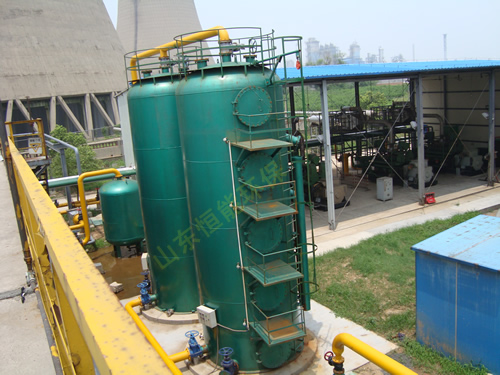废矿物油是指机动车辆维护,企业在生产经营过程中产生的各种废油,废气,废物柴油、废油、真空泵油、废油、废热处理油,齿轮油,废液压变压器油和其他废物矿物油为基础的各种润滑油失去原有的功能和废弃污泥的石油在石油开采和炼油和石油的过程中,矿物油的沉积物的存储过程,机械、电力、运输和其它设备来取代石油和洗油、金属轧制、加工过程的废油,含油废水处理的过程浪费石油和污泥,残油和过滤器媒体期间生成石油加工和石油都是废矿物油再生,不适合原来的使用和属于有毒物质。其中含硫化合物、石油物质和富营养化对水土污染尤为严重,在全国危险废物名录中名列第八。
Waste mineral oil refers to all kinds of waste oil, waste gas, waste diesel oil, waste oil, vacuum pump oil, waste oil, waste heat treatment oil, gear oil, waste hydraulic transformer oil and other waste mineral oil based on the maintenance of motor vehicles and the production and operation process of enterprises. In the process of oil exploitation, oil refining and oil refining, the mineral oil will sink In the process of storage, machinery, electric power, transportation and other equipment are used to replace the waste oil in the process of oil and wash oil, metal rolling and processing. In the process of oil-bearing wastewater treatment, oil and sludge are wasted. Oil processing and oil generated during the period of residual oil and filter media are both waste mineral oil regeneration, which are not suitable for the original use and belong to toxic substances. Among them, sulfur compounds, petroleum substances and eutrophication are particularly serious to water and soil pollution, ranking eighth in the national list of hazardous wastes.
废弃矿物油和焦油渣被列为危险废物,编号为HW08和HW11,是原国家环境保护总局1999年发布的第11号。5显然管理办法规定的危险废物重复,要求加强危险废物转移的有效监督,实施危险废物转移系统,要求所有危险废物必须参考合格单位,和用于将复制的过程管理,从源到结束整个过程监测、预防处置危险废物是危险和伤害。
Waste mineral oil and tar residue are classified as hazardous wastes, with the numbers of hw08 and hw11, which were issued by the former State Environmental Protection Administration in 1999. It is obvious that the hazardous waste stipulated in the management method is repetitive, which requires strengthening the effective supervision of hazardous waste transfer, implementing the hazardous waste transfer system, requiring all hazardous wastes to refer to the qualified units, and the process management for copying, monitoring the whole process from the source to the end, and preventing the disposal of hazardous wastes from being dangerous and harmful.

废弃矿物油或焚烧不仅造成严重的环境污染,而且造成严重的资源浪费。和焦油渣含有苯、酚、萘和其他有毒物质,对人体有致癌作用,如果直接跑到对方或混乱,不仅可以直接影响大气环境的质量,而且还严重污染地下水和土壤环境,属于危险废物(HW11),研究表明,一升矿物油基润滑剂对一百万升水污染造成的0.1微克/克的矿物油,可减少水介质和小虾的使用寿命达20%,而矿物油污染地下水达100年之久。事实上,废弃矿物油的成分不超过2%?10%的变质物质,剩下的90%?98%是可再生和可回收的,焦油残渣可以用来制造燃料油和沥青,把废物变成有价值的资产。特别是汽车4S店废机油具有很高的回收价值。因此,大力开展废矿物油和废焦油渣的回收利用,是提高资源回收效率、保护环境、建设资源节约型社会的重要途径之一。
Waste mineral oil or incineration not only causes serious environmental pollution, but also causes serious waste of resources. And tar dregs contain benzene, phenol, naphthalene and other toxic substances, which have carcinogenic effect on human body. If they directly run to each other or are confused, they can not only directly affect the quality of the atmospheric environment, but also seriously pollute the groundwater and soil environment. They are hazardous wastes (hw11). Research shows that one liter of mineral oil-based lubricant causes 0.1 μ g / g of mineral oil for one million liters of water pollution, which can reduce the water medium The service life of quality and shrimp is up to 20%, while mineral oil has polluted groundwater for 100 years. In fact, the content of waste mineral oil is not more than 2%? 10% of metamorphic materials, and the remaining 90%? 98% is renewable and recyclable. Tar residue can be used to make fuel oil and asphalt, turning waste into valuable assets. Especially the waste engine oil from 4S shop has a high recycling value. Therefore, it is one of the important ways to improve the efficiency of resource recovery, protect the environment and build a resource-saving society to vigorously carry out the recovery and utilization of waste mineral oil and waste coke oil residue.
据市场研究废矿物油和焦油渣除了传统的再生的方法,和一个流动的趋势是不合理的集中在白土精制,通过精炼方法,废矿物油破解城市轻燃料油、沥青焦油渣废料回收的整个过程浪费,单位产量低,也会产生新的污染,属于国家禁止项目。但由于土壤改良技术含量低,进入门槛低,存在一定的需求市场,一直处于反复禁止的状态。
According to the market research, in addition to the traditional regeneration method, the waste mineral oil and tar residue flow is unreasonable and concentrated in the clay refining. Through the refining method, the waste mineral oil can break the waste of the whole process of the recovery of urban light fuel oil and asphalt tar residue, with low unit output and new pollution, which belongs to the project prohibited by the state. However, due to the low content of soil improvement technology and low entry threshold, there is a certain demand market, which has been in the state of repeated prohibition.
